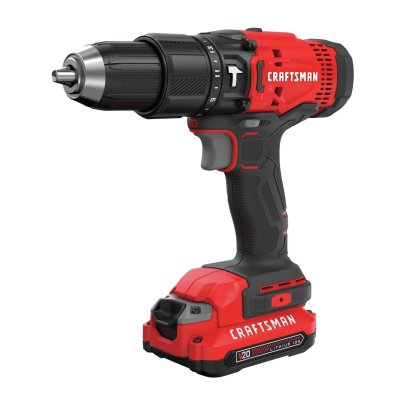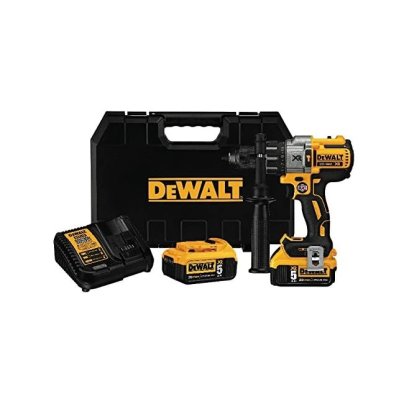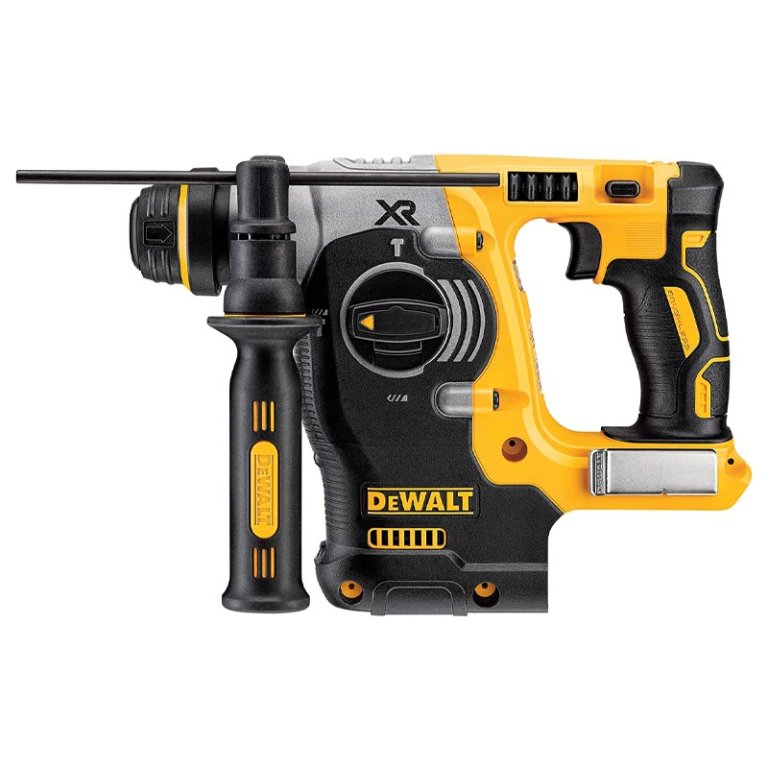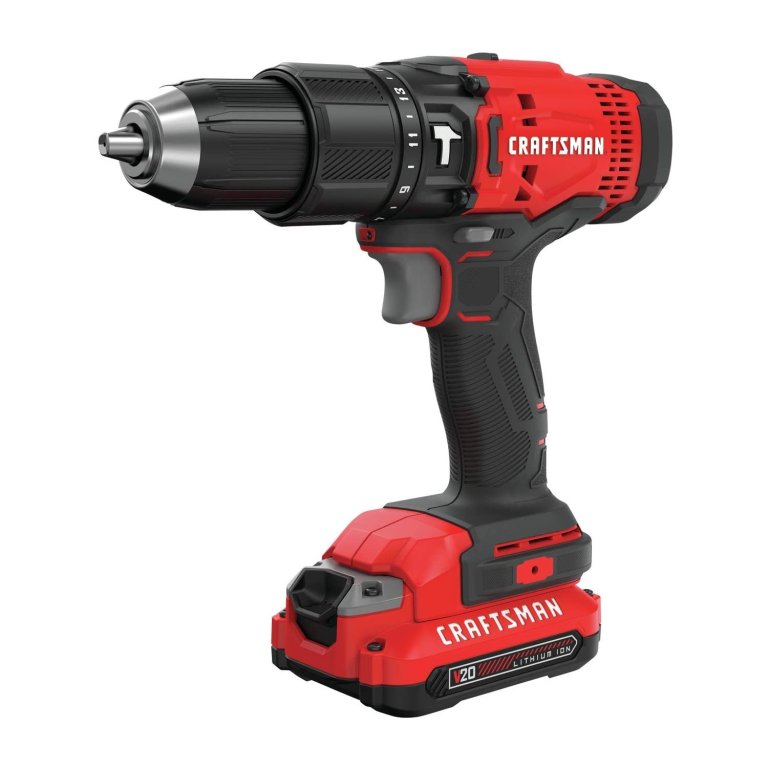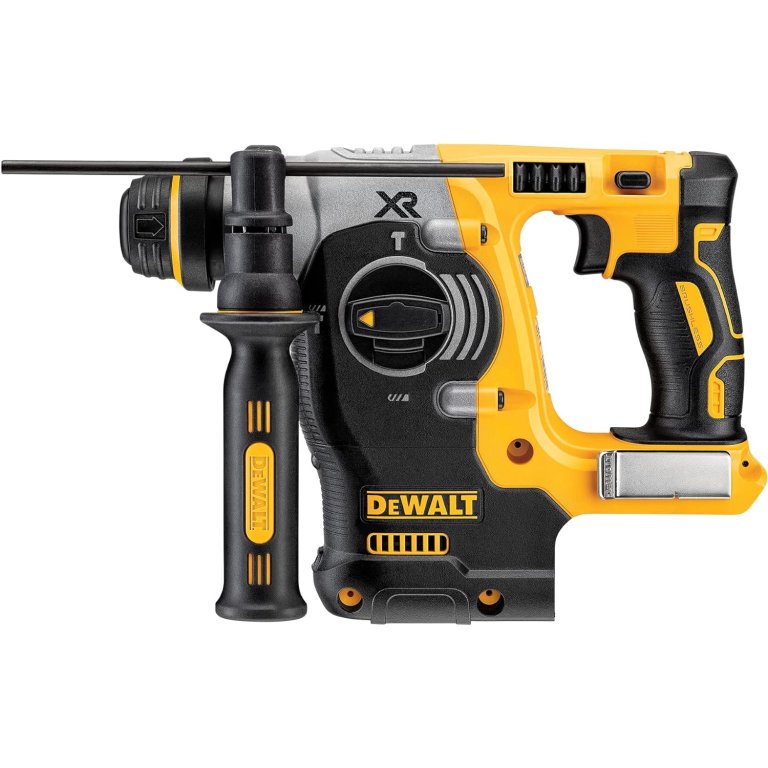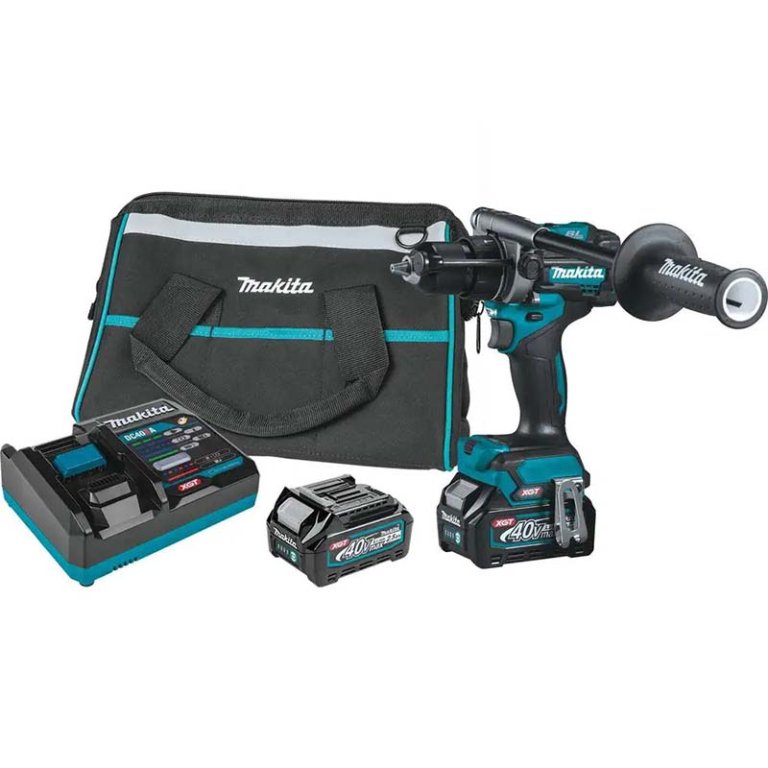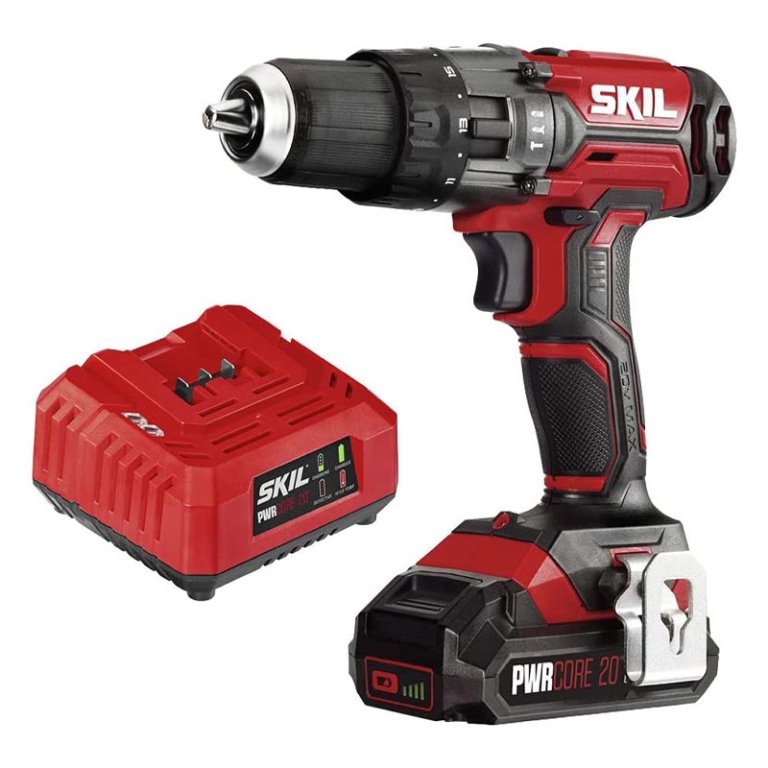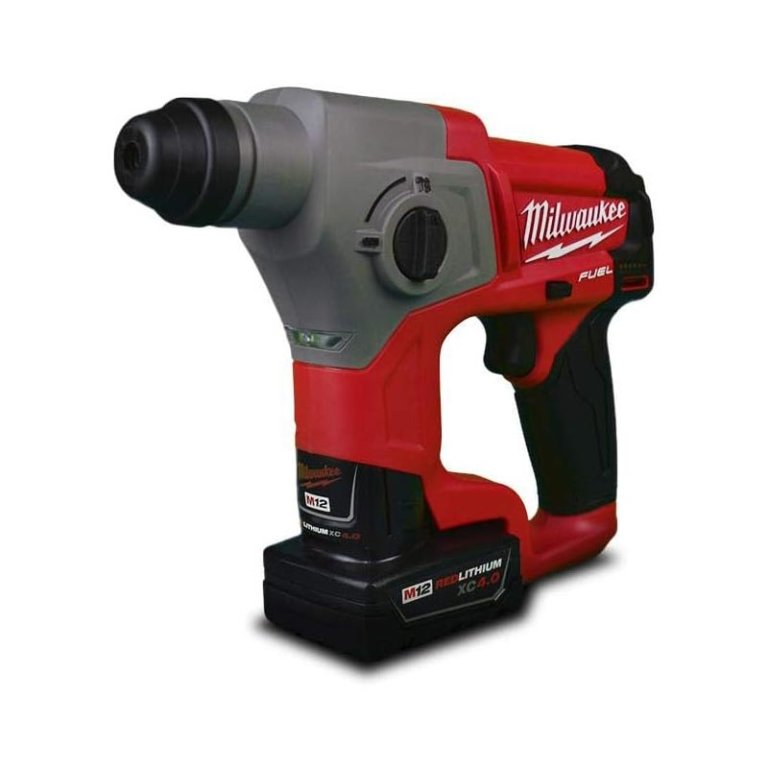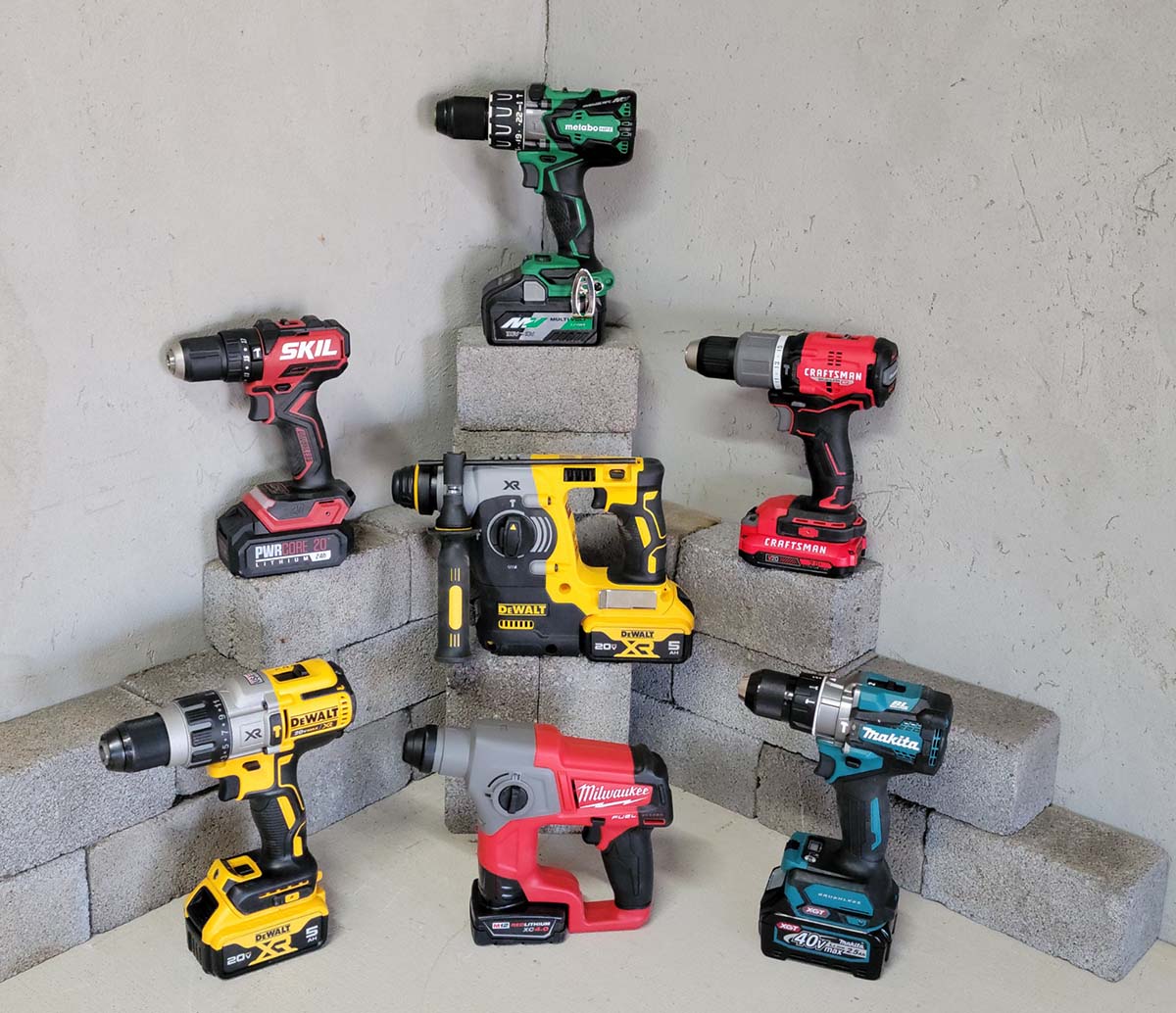
We may earn revenue from the products available on this page and participate in affiliate programs. Learn More ›
Drilling through concrete, bricks, and stone requires more force than even the most powerful corded drill drivers can provide—and cordless hammer drills have enough oomph (plus the convenience of battery power) to complete such tasks. Since this type of power tool is less common than a standard battery-operated drill, we tested a half-dozen top options to help you select a model worth your money. After using each battery hammer drill to bore holes in concrete, ceramic tile, and cinder brick, we documented each tool’s ability, performance, and ease of use before assigning all worthy options awards.
Based on our tests and insights from a building industry expert, we chose the DeWalt 20V MAX XR Brushless 1-Inch Rotary Hammer as our favorite hammer drill for its ergonomic design and excellent performance. This model and the rest of our recommended cordless drills scored the highest in our hands-on testing and represent the best cordless hammer drills on the market.
- BEST OVERALL: DeWalt 20V MAX XR Brushless 1-Inch Rotary Hammer
↓ Jump to Review - BEST BANG FOR THE BUCK: Craftsman V20 Cordless ½-Inch Hammer Drill Kit
↓ Jump to Review - BEST HEAVY-DUTY: DeWalt 20V MAX XR ½-Inch Hammer Drill/Driver Kit
↓ Jump to Review - BEST MEDIUM-DUTY: Makita 40V MAX XGT ½-Inch Hammer Driver-Drill Kit
↓ Jump to Review - BEST LIGHT-DUTY: Skil PWRCORE 20V ½-Inch Hammer Drill Kit
↓ Jump to Review - BEST COMPACT: Milwaukee M12 Fuel ⅝-Inch SDS Plus Rotary Hammer Kit
↓ Jump to Review
Before You Buy a Cordless Hammer Drill
A cordless rotary hammer drill works by spinning a drill bit while simultaneously generating a rapid hammering action—making it ideal for boring into concrete, bricks, stone, or other masonry. Equipped with heavy-duty components and a high amount of torque, this type of tool is typically more powerful than necessary for tasks generally associated with using a cordless electric drill. Before buying one, consider whether you need to mix large amounts of concrete and paint or drill through bricks and other masonry. If not, you probably don’t need a hammer drill and can save a bit of money using a standard drill driver.
Cordless Hammer Drill Comparison Chart
| Product Name | Maximum Speed | Battery Voltage | Weight |
| DeWalt 20V MAX XR Brushless 1-Inch Rotary Hammer | 1,100 RPM/4,600 BPM | 20-volt (V) | 6.8 pounds |
| Craftsman V20 Cordless ½-Inch Hammer Drill Kit | 1,500 RPM/25,500 BPM | 20V | 6.1 pounds |
| DeWalt 20V MAX XR ½-Inch Hammer Drill/Driver Kit | 2,250 RPM/38,250 BPM | 20V | 4.4 pounds |
| Makita 40V MAX XGT ½-Inch Hammer Driver-Drill Kit | 2,600 RPM/39,000 BPM | 40V | 6 pounds |
| Skil PWRCORE 20V ½-Inch Hammer Drill Kit | 1,450 RPM/ 21,750 BPM | 20V | 4.32 pounds |
| Milwaukee M12 Fuel ⅝-Inch SDS Plus Rotary Hammer Kit | 900 RPM/ 6,200 BPM | 12V | 3.9 pounds |
Our Top Picks
The following hammer drills excelled in our hands-on tests. Find out what we liked about each one before choosing the best cordless hammer drill for your needs.
Best Overall
DeWalt 20V MAX Brushless 1-Inch Rotary Hammer
See ItWhat We Like
- Ergonomic design and comfortable grip
- 3 modes: drill only, hammer only (chipping), or combo
- Adjustable depth-stop rod
What We Don’t Like
- Slightly heavy for delicate ceramic tile
Specs
- Maximum speed: 1,100 RPM/4,600 BPM
- Battery voltage: 20-volt (V)
- Weight: 6.8 pounds
Traditionally, rotary hammers are large and unwieldy, but that isn’t the case with the DeWalt cordless rotary hammer. This heavy-duty tool has a standard pistol-style grip, which makes it easy to grasp and control. It has a brushless motor that generates up to 4,600 beats per minute (BPM) and a top speed of 1,100 rotations per minute (RPM). While this is lower than some of the other models we tested, that’s simply because this DeWalt drill is built for long-term power rather than speed.
This model is a tool-only purchase, so we paired it with a DeWalt 5.0-amp-hour (Ah) rechargeable battery for testing. If you need to buy a battery, we wouldn’t suggest anything less than a 3.0Ah option, as this tool simply has too much power and torque for anything without at least that much capacity. Once you insert a battery, you can use the drill on one of three modes: drill only, chipping, or drill and hammer combined. This unit also has an adjustable depth rod, a side accessory handle, a belt hook, and a slotted drive shaft/system (SDS) chuck.
In testing, this rotary hammer drill powered through all our masonry tasks without a glitch, and its ergonomic design allowed us to get a firm grip to maintain steady pressure. This specific model is a little beefy for drilling through ceramic tile, but we found we were able to drill smooth holes through tiles without cracking or chipping the surface glaze by switching to a smaller bit.
What our tester says: “We especially like this DeWalt’s chipping feature, which worked well for getting old grout off used bricks. Even though we don’t need this mode on a daily basis, it’s so much quicker and easier than chipping away mortar by hand using a hammer and chisel that we’re really glad it’s an option.”—Glenda Taylor, Product Reviews tester and writer
Read the full review: DeWalt 20V MAX XR Brushless 1-Inch Rotary Hammer
Get the DeWalt 1-inch cordless hammer drill at Amazon, Lowe’s, Ace Hardware, The Home Depot, or Walmart.
Best Bang for the Buck
Craftsman V20 Cordless ½-Inch Hammer Drill Kit
See ItWhat We Like
- 2 speed options plus drill and hammer modes
- Suitable for light- to medium-duty projects
- Onboard LED is helpful in low-light situations
What We Don’t Like
- Included batteries are relatively low capacity
Specs
- Maximum speed: 1,500 RPM/25,500 BPM
- Battery voltage: 20V
- Weight: 6.1 pounds
Though it’s not a heavy-duty model like our top pick, the Craftsman V20 hammer drill is efficient, affordable, and powerful enough for many DIY uses. It comes with two 1.3Ah batteries and produces up to 1,500 RPM at high speed, sufficient for most light- or medium-duty projects. When it comes to boring holes in brick or concrete, the Craftsman produces up to 25,500 BPM—more than respectable from a value-priced model. We wouldn’t suggest it for someone who needs to drill mainly in dense concrete, but it’s a good pick for drilling through ceramic tile, cinder bricks, or the occasional concrete floor.
In our tests, we were able to make clean holes in tile without causing chipping or cracking on both the high and low speeds. When drilling holes in concrete and cinder brick, the Craftsman tended to bog down slightly if we used too much pressure. That could be related to both its brushed motor—brushed motors aren’t quite as powerful as brushless motors—or it could be associated with its low-capacity batteries. Craftsman tool users with higher-capacity batteries may want to use them in this drill.
Get the Craftsman cordless hammer drill at Amazon, Lowe’s, or Ace Hardware.
Best Heavy-Duty
DeWalt 20V MAX XR ½-Inch Hammer Drill/Driver Kit
See ItWhat We Like
- LED light is dimmable and features a spotlight mode
- Two 5.0Ah batteries and charger are included
- Comes with a hard case for storage
What We Don’t Like
- Batteries are a bit hard to remove from the tool
Specs
- Maximum speed: 2,250 RPM/38,250 BPM
- Battery voltage: 20V
- Weight: 4.4 pounds
The DeWalt 20V MAX XR cordless drill set is a dependable and powerful hammer drill well suited to DIY and professional use, making it an excellent choice for an all-around hammer drill. As the second DeWalt in our lineup of the best cordless hammer drills, this top-notch pick is a conventional model rather than a rotary one. It features a brushless motor for enhanced power and three modes: drill, hammer drill, and driver.
In testing, the DeWalt hammer drill was impressive. We drilled quickly and without issue through concrete and cinder brick. We did get some surface chipping when drilling through ceramic tile, but that’s not unusual when working with powerful hammer drills. Still, this model’s variable-speed trigger made it much easier to start hammer drilling slowly so we didn’t shatter our glazed tile’s surface. It also has a dimmable LED light that users can set on low to conserve battery power or crank up to high for spotlight-bright illumination. We relied on that handy addition more than once in our tests, and we hope we see that feature added to more power tools.
What our tester says: “We were impressed when we discovered that this hammer drill comes with two 5.0Ah batteries. Rechargeable lithium-ion batteries can be pricey—sometimes costing as much as the power tool itself—so it was a treat to get two high-capacity batteries alongside this excellent tool.”—Glenda Taylor, Product Reviews tester and writer
Get the DeWalt ½-inch cordless hammer drill at Amazon, Lowe’s, The Home Depot, Walmart, or Northern Tool + Equipment.
Best Medium-Duty
Makita 40V MAX XGT ½-Inch Hammer Driver-Drill Kit
See ItWhat We Like
- Low vibration reduces hand and arm fatigue
- Works in 3 modes: hammer, standard, and driver
- Ample torque for drilling through concrete
What We Don’t Like
- Having to press and unlock digital clutch slows use
Specs
- Maximum speed: 2,600 RPM/39,000 BPM
- Battery voltage: 40V
- Weight: 6 pounds
Makita has a reputation for producing top-notch tools, so while we were excited to test its new hammer drill, we were somewhat skeptical since it features a digital clutch. Considering that all the hammer drills we’ve used previously have clutch rings for manually adjusting the torque needed to insert screws without stripping out the heads, we wondered how a digital clutch would fare.
To find out, we switched to driver mode to turn on the digital clutch and tested its torque and slip by inserting screws into pine lumber. Overall, it was as accurate as any manual clutch we’ve worked with, but you have to press and temporarily hold an additional digital lock each time you want to select the clutch range. For quick-moving professionals, repeatedly needing to unlock the digital clutch may become annoying, though it may not bother occasional-use DIYers at all.
Still, our main testing concern was how well the Makita could bore holes in concrete and other masonry materials, and in that area, it performed very well. Its brushless motor delivered ample torque and power, and the percussion hammering was reasonably smooth and didn’t reverberate through our hands and arms as some hammer drills do. The Makita offers two speeds and three modes: hammer drill, standard drill, and driver (for screws). It also has a bright LED light, a removable bar handle for two-hand stability, two 2.5Ah batteries, and a charger.
Get the Makita cordless hammer drill at The Home Depot or Acme Tools.
Best Light-Duty
Skil PWRCORE 20V ½-Inch Hammer Drill Kit
See ItWhat We Like
- Also drills in wood and metal
- 2 speed settings and 3 modes
- Has an LED light and belt clip
What We Don’t Like
- Not as powerful as the others we tested
Specs
- Maximum speed: 1,450 RPM/ 21,750 BPM
- Battery voltage: 20V
- Weight: 4.32 pounds
When it comes to minor home repairs or DIY projects, the Skil 20V ½-inch hammer drill is a reliable option. This three-in-one tool functions as a hammer drill, drill, and screwdriver and has two speed settings. It comes with a 2.0Ah battery, which is on the low-capacity side yet still powerful enough for drilling the occasional hole in a concrete patio or basement floor. Since it doesn’t have a brushless motor, it’s best for light-duty tasks.
In our tests, the Skil successfully drilled through cinder brick and ceramic tile, creating very smooth holes without causing chipping. In hammer mode, it vibrated more than other models we tested, but it wasn’t too much to handle. We think this Skil is a useful and cost-effective option for around-the-house drilling and light masonry tasks so long as you don’t need to drill more than a dozen holes in succession. We also recommend you don’t use too much pressure, as its motor bogs down a bit under increased force but drills just fine once you ease up.
Get the Skil cordless hammer drill at Amazon or Lowe’s.
Best Compact
Milwaukee M12 Fuel ⅝-Inch SDS Plus Rotary Hammer Kit
See ItWhat We Like
- Compact and lightweight
- LED light is nice and bright
- Plenty of power and torque for a small cordless electric drill
What We Don’t Like
- No accessory bar for 2-handed use
Specs
- Maximum speed: 900 RPM/ 6,200 BPM
- Battery voltage: 12V
- Weight: 3.9 pounds
Hammer drills are typically more powerful than standard drills, so we were initially puzzled to see Milwaukee making a 12-volt version when most are 20 or even 40 volts. Surprisingly, this compact model proved pretty powerful in our tests, quickly drilling holes in concrete, cinder brick, and tile. We found it perfect for use in tight spots and appreciated that its smooth and comfortable hammering action felt more like a gentle vibration than percussion.
Still, this 12-volt tool isn’t going to replace a full-size rotary hammer drill anytime soon. Its low-voltage motor is better suited to light-duty tasks rather than commercial or heavy DIY use, and it only has two modes: drill and hammer drill. Since it does provide excellent performance for its size, it would be a quality pick for a pro, such as an electrician or plumber, who has to drill occasional holes in a masonry wall to run wiring or conduit. It’s lightweight enough to use as a one-handed hammer drill, though it would be nice if it came with an accessory bar for added stability.
Get the Milwaukee cordless hammer drill at The Home Depot or Amazon.
Jump to Our Top Picks
How We Tested the Best Cordless Hammer Drills
To select models for our hands-on tests, we looked at the power output, speed, motor type, battery type, weight, and unique features of dozens of popular options. We then fit a select few with masonry bits and used them to drill through concrete, ceramic tile, and cinder bricks. As we tested, we awarded points based on performance, material quality, ergonomics, and efficacy of special features. We then used the scores to determine which award each tool deserved.

What to Consider When Choosing a Cordless Hammer Drill
Certain features make some hammer drills better than others. Consider the following before buying one of the top cordless drills recommended above.
Drilling Materials
A standard drill and drill bit will barely scratch the surface of porcelain tile, a concrete walkway, or a stone countertop, yet a hammer drill fitted with a masonry bit will easily bore through these dense materials. Masonry bits have wings on the tips that help them remove dust as they drill, and their points are more chisel-like than those on standard bits. Even the best drill bits will dull or break almost immediately if they aren’t meant to penetrate the surface of masonry material, so using proper masonry bits is essential for dense surfaces.
Motors
Power tools like cordless drills have either brushed or brushless motors. Brushed motors use older technology to send power to a coil attached to a shaft. As the shaft begins to spin, the drill delivers power and torque.
Brushless motors are far more efficient. They use sensors and control boards to send an electrical current to coils that spin a magnet attached to a shaft. This method produces significantly more torque and uses far less battery power than a brushed motor. If you need to drill numerous holes, purchasing a brushless hammer drill might be worth the extra expense for the time it saves.
RPM, Torque, and BPM
When it comes to speed, consider a drill with a maximum RPM speed of 1,000 or more. Though that much speed is probably not necessary to drill through masonry materials, it allows the tool to be used as a drill driver when it’s not boring holes through concrete and brick.
Torque (twisting force) is also essential. To indicate torque, manufacturers may use “unit watts out” or UWO, which is a complex measurement of drill power at the chuck. A drill with at least 700 UWO should serve most purposes. Not all manufacturers list UWO, however.
Additionally, beats per minute, or BPM, should be a consideration. This measurement unit describes how often the hammer gear strikes the chuck per minute. A hammer drill with a BPM rating of 20,000 to 30,000 is suitable for most scenarios, though heavier-duty models might offer lower BPM in exchange for increased torque. For example, drilling large-diameter holes may be easier with a hammer drill with high torque power, even if it has a lower BPM rating.
Clutch
Because hammer drills create so much torque, users need a way to regulate how much of that torque is available when using the drive feature on the tool to insert screws (if applicable). Too much torque can break a driver bit or strip out the head of the screw.
Manufacturers may incorporate adjustable clutches in their hammer drills to control torque output, but not all models have this option. Adjusting the clutch usually requires users to twist a collar at the base of the chuck to the correct position, though that position is always different from tool to tool and is dependent on the type of drilled material. For example, porcelain tile, which is very hard, might require a high clutch setting (as long as the fastener can handle it), while porous cinder brick will require less.
Chuck
There are two types of chucks to become familiar with: 3-jaw chucks and SDS chucks.
Most medium-duty hammer drills use 3-jaw chucks. They clamp down on a round or hexagonal surface when the user twists the chuck. Three-jaw chucks allow users to use a wide range of drill bits and driver bits, which is why they’re nearly universal on drill drivers. They come in ½-inch and ⅜-inch sizes, with the larger size being more heavy duty.
Rotary hammers use SDS chucks that accept SDS bits. These bits have grooved shanks that lock into place. SDS is a German innovation, and the letters originally stood for the German words “steck, dreh, sitz,” which mean “insert, twist, stay.” Today, SDS is more commonly used to represent the English phrase “slotted drive system” or “slotted drive shaft.” These bits are different because rotary hammers provide massive force, which requires a more secure method of holding onto a bit.
Battery Type and Life
The main types of batteries that come with any cordless power drill are nickel-cadmium (NiCd for short) and lithium-ion. Lithium-ion batteries are replacing NiCd because they’re more efficient and last longer during use and in overall lifespan. They’re also considerably lighter. All the models that we tested came with lithium-ion batteries.
Battery life during use is typically measured in Ah. For light-duty drill drivers, 2.0Ah batteries may be sufficient. When slamming a bit into masonry, however, users might want a battery to last longer. They will want to look for batteries with amp-hour ratings of 3.0Ah or more or choose a corded drill instead. For those who need higher amp-hour ratings, batteries up to 12Ah can typically be purchased separately.
Size and Weight
When shopping for the best cordless hammer drill for your particular needs, remember to consider project requirements. For example, drilling through porcelain wall tiles doesn’t require much torque, speed, or BPM. A light-duty, compact hammer drill weighing around 2 pounds (without the battery) can do the trick. On the other hand, drilling large holes for structural anchors in concrete will require a much larger, heavier hammer drill, possibly even a rotary hammer, which can weigh as much as 8 pounds without the battery.
A medium-duty hammer drill is an excellent choice for many DIY applications since it can tackle most projects. However, it will be significantly heavier than a standard drill driver (often as much as twice the weight), so it might not be ideal as the only drill driver in a workshop.
FAQs
If you’ve never used a hammer drill before, you might still have questions about the tools and how they work. Below are answers to some of the most frequently asked questions to help point you in the right direction.
If it has a chipping feature, you can use a rotary hammer drill as a chisel, such as our best overall pick in this lineup.
Yes, many hammer drills function as drill drivers, though their high power might be overkill for most projects around the house.
Here are a few reasons your drill may not be hammering:
You’re not putting enough pressure on the bit. The drill must feel some resistance from the bit to hammer it into the material.
Your drill isn’t in hammer mode. There might be a dial on the side of the drill or a collar at the top of the machine that allows you to switch the drill into and out of hammer mode.
Your hammer gear might have broken. Most likely, this is due to age or misuse, but it’s best to check into a new one if this is the case.
To answer this question, we interviewed Eduard Mirzoian, CEO of the emergency restoration company Restorerz. Eduard says that “some materials do not take as well to drilling using cordless hammer drills. Take, for example, extremely difficult materials like stone or massive metal.” You may need a corded hammer drill that offers more power and torque or diamond-tip bits to breach incredibly dense materials such as these.
According to building expert Eduard Mirzoian, “It is worth having a cordless hammer drill if portability and versatility are crucial.” He points out that cordless hammer drills allow you to work away from outlets but that you also need to be sure you consider the battery life necessary for your project so you don’t run out of power in the middle of your task.
Meet the Tester
Glenda Taylor is a product tester and writer specializing in construction, remodeling, and real estate. She and her husband own a general contracting company, and she is experienced in both residential and commercial building applications. Taylor tests a wide range of power tools as well as other home improvement, household, and lawn-and-garden products.
Additional research provided by Tom Scalisi.

